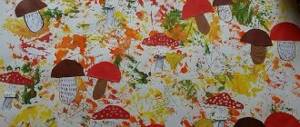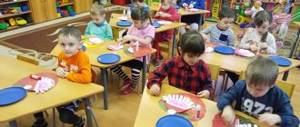Preview:
Municipal preschool institution kindergarten No. 44 of the urban district of the city of Neftekamsk of the Republic of Bashkortostan
Work program for the appliqué club
Educator: Ermakova N.I.
“The sources of children's creativity and talent are at their fingertips. In other words:
the more skill in a child's hand,
the smarter the child"
V. A. Sukhomlinsky.
A child learns the world through manipulation, that is, actions with various objects that allow him to recognize and study their properties, while learning his creative abilities and changing what he touches. One of the child’s assistants in this most important task for his development is working with paper.
Applique is one of the simplest, most exciting and effective types of artistic activity. Children enjoy working with paper because it is easy to process. Non-traditional techniques for working with paper and non-traditional materials are especially attractive for children: torn, crumpled paper, paper napkins, cotton pads, etc. An unusual combination of materials and tools, accessibility, and simplicity of execution techniques satisfy the research need for them, awaken a feeling of joy, success, and develop labor skills.
Applique (paper plastic technique) is a synthesis of different types of visual activities: modeling, appliqué, drawing, designing from paper. Images in paper plastic are made in a semi-volume version; all parts and details are glued onto cardboard, which serves as a color background, which allows children to create bright individual and collective compositions.
Middle group. Junior preschool age. Children 4 - 5 years old
Plan of the circle “Visiting Grandfather Local History” in the middle group Dates Events September 1. Tour of the kindergarten and familiarization with the work of the employees Purpose: to give a general idea of the kindergarten and its functions 2. Conversations “My group”
,
“My friends”
Goal: To develop basic ideas about friendships 3. A series of conversations “Who are we...
Work plan for the theater club in the middle group of MKOU Gorodok secondary school No. 2 branch "Nikolo-Petrovskaya school"
(preschool level) Work plan for the "Fairy Tale"
in the middle group
"Sun"
for the 2020 - 2020 academic year Head: Blagireva L.G. Goal: To develop preschoolers’ interest and desire to participate in dramatization games….
Application club program for the middle group
Natalia Robertus
Application club program for the middle group
Work program for the appliqué club in the middle group “Paper Kaleidoscope”.
Compiled by the teacher of the Chistoprudnensky Children's School "Fairy Tale" Robertus N.V.
Explanatory note
The relevance of the program lies in introducing children to creativity and developing their abilities. Application in the development of motor skills allows the child to learn to perform subtle and precise movements of the fingers, and the work of the thinking and speech centers of the brain directly depends on this.
Currently, there is a problem of aesthetic education of preschoolers, which involves developing the ability to perceive beauty in nature, art, and the surrounding reality , awakening aesthetic feelings in children, developing aesthetic taste, as well as skills in creative activity. Aesthetic education in kindergarten creates the prerequisites for the full subsequent artistic development of each child, including the formation of visual creativity.
To support this interest, it is necessary to stimulate the imagination and the desire to engage in creative activities. In classes in drawing, modeling, and appliqué, children develop emotional and aesthetic feelings, artistic perception, and improve their skills in visual and constructive creativity.
Learning appliqué involves familiarizing yourself with the material, acquiring the ability to cut out various shapes, arrange them on a sheet of paper in a certain order and paste them in accordance with the image and plot.
We consider various work with paper to be the most interesting, entertaining and favorite way to develop fine motor skills. To solve these problems, a circle .
Purpose of the program
Teaching children the basics of visual literacy and their active creative development, taking into account the individuality of each child through visual arts classes and familiarization with the achievements of world artistic culture.
Formation of aesthetic attitude and artistic and creative abilities in visual activities in preschool children.
Program objectives
The main objectives of application training are as follows :
- distinguish geometric shapes, know their names (circle, square, oval, rectangle, triangle, rhombus)
;
-introduce primary, complementary colors and their shades, mastering the ability to create harmonious combinations;
-know the sizes and quantities: large, small forms; one shape more (less)
another, one, several, many forms;
-develop compositional skills: rhythmically arrange identical forms in a row or alternate two or more forms;
- build an image depending on the shape of the sheet - on a strip, square, rectangle, circle;
- create an image of an object from separate parts;
-arrange objects in a plot applique .
Mastering basic cutting techniques:
a) cutting paper straight, along folds and by eye;
b) cutting out rounded shapes by rounding corners, symmetrical shapes from paper folded in half, several times, like an accordion;
c) cutting out asymmetrical shapes - silhouette and from separate parts; d) cutting along the contour;
e) creating a shape by tearing off (pinching off)
pieces of paper.
Mastering basic gluing techniques (using a brush, glue, rag; the ability to sequentially glue forms).
Forms of work:
• individual (each child must make his own application )
;
• group (when performing collective work, each group performs a specific task);
• collective (in the process of preparing and performing a collective composition, children work together, without sharing responsibilities).
• with parents (open lesson)
Implementation deadlines
1 year
Lesson mode
2 times a month no more than 20 minutes
Expected results
— interest in the art of appliqué ;
- knows how to hold scissors correctly in the right hand and work with them;
-can cut in a straight line;
- knows how to make images of different objects from stripes;
- knows how to cut a circle from a square by rounding the corners;
- knows how to cut an oval from a rectangle by rounding the corners;
- creates images of objects from parts;
- knows how to choose colors that combine with each other;
- knows how to make patterns from prepared geometric elements on a strip, square, rectangle, circle, alternating them by color, shape and size;
- knows how to decorate products with felt-tip pens;
- possesses the skills of accurate cutting and pasting;
— familiar with the technique of making frescoes;
Literature:
Application for children 4 – 5 years old . D. N. Koldina
Annual thematic planning of classes.
September
Lesson 1 Screen with vegetables Expand children's knowledge about vegetables. Reinforce the techniques of applying glue with a brush to the back side of the figure. Continue to strengthen the ability to apply a part coated with glue to a sheet of paper and press it tightly with a cloth. Colored paper. Application from objects . Group activity. See page 14 No. 8
Lesson 2 Screen with fruits Expand and clarify children's ideas about the variety of fruits. Reinforce techniques for careful gluing. Develop mindfulness. Colored paper. Application from objects . Group activity. See page 16 No. 8
October
Lesson 3 Hedgehog Learn to tear small pieces from a sheet of paper, apply glue to them and stick them on cardboard inside the outline. Continue learning how to design an applique using felt-tip pens. Colored double-sided paper. Breaking off is a mosaic. See page 18 No. 8
Lesson 4 Autumn tree Expand children's knowledge about the techniques of autumn. Continue to teach how to tear small pieces from a sheet of paper, apply glue to them, and glue pictures in the right place. Colored double-sided paper. Breaking off is a mosaic. See page 23 No. 8
November
Lesson 5 Stripes on a cup Teach children to hold scissors correctly, squeeze and unclench rings, cut in a straight line, decorate an object using cut strips. Colored paper. Decorative applique . See page 24 No. 8
Lesson 6 Striped rug Teach children to hold scissors correctly, squeeze and unclench rings, cut in a straight line. Learn to decorate a rectangular object with colored stripes, alternating them by color. Colored paper. Decorative applique . See page 27 No. 8
December
Lesson 7 White snowflake Continue to teach how to hold scissors correctly, cut the square into narrow strips. Practice composing a planned object from strips. Strengthen the skills of neat and even gluing. White paper. Application from parts of an object . See page 31 No. 8
Lesson 8 Christmas tree from the forest. Strengthen the ability to hold scissors correctly. Continue learning to cut out round shapes from squares, cutting off the corners. Teach children to work together. Colored paper.
Application from objects.
Group activity. See page 34 No. 8
January
Lesson 10 Dog Kennel Learn to cut a square into two triangles, and a circle into two semicircles. Continue to learn how to compose and carefully paste an image of an object from several parts. Learn to work in pairs. Colored paper.
Application from parts of an object . See page 37 No. 8
Lesson 9 Garland of flags Learn to fold a rectangle in half, connect the sides of the folded rectangle with glue, passing a thread between them. Learn to alternate flags by color. Colored paper. Making a garland.
Group activity. See page 32 No. 8
February
Lesson 11 Teremok Continue to develop the skill of cutting a rectangle into long strips. Strengthen the ability to assemble a conceived object from strips. Learn to place the object in the center of the sheet, stick it neatly and evenly. Colored paper.
Application from parts of an object . See page 41 No. 8
Lesson 12 Warship Learn to cut a rectangle to a trapezoid. Strengthen the ability to assemble an object from separate parts. Learn to place the object in the center of the sheet. Colored paper.
Application from parts of an object . See page 44 No. 8
March
Lesson 13 Tumblers Continue learning to cut out circles, smoothly rounding the corners of the square, to compose a depicted object from several circles, placing them correctly on the sheet. Colored paper.
Application from parts of an object . See page 47 No. 8
Lesson 14 Flower in a pot Continue to learn how to cut a trapezoid from a square, cutting off the corners, tear off small pieces from a napkin, crumple them into a ball and stick them on. Colored paper and napkins. Applique made from rolled up pieces of napkins. See page 50 No. 8
April
Lesson 15 Sunshine To strengthen children’s skills in cutting a rectangle into strips, cutting a circle from a square. Continue to teach how to assemble a planned object from parts and stick it on cardboard, placing it in the center of the sheet. Colored paper.
Application from parts of an object . See page 54 No. 8
Lesson 16 Willow branch Continue teaching children to tear off pieces of cotton wool, lightly roll them between their fingers and stick them on a landscape sheet in the right place. Learn to color cotton balls. Colored paper and cotton wool.
Applique from parts of an object and cotton balls. See page 57 No. 8
May
Lesson 17 Balloons Learn to cut out ovals from rectangles and stick them on drawn strings of the same color. Develop thinking and eye. Colored paper.
Application from objects . See page 58 No. 8
Lesson 18 Pyramid Reinforce the ability to cut ovals from rectangles, glue ovals, starting with the largest and ending with the smallest. Cultivate compassion and kindness. Colored paper.
Application from objects . See page 60 No. 8





